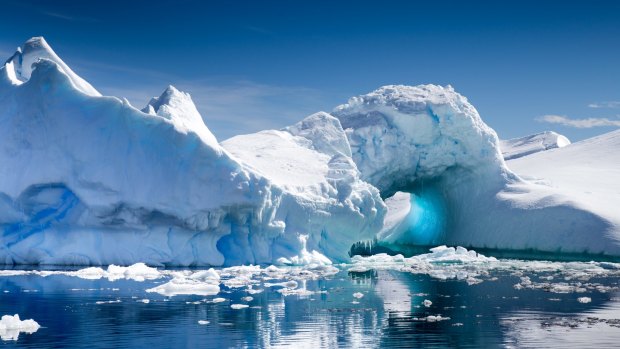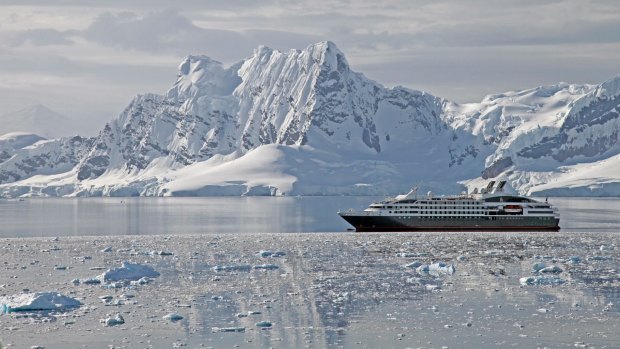This was published 5 years ago
Antarctica's ice is one of the most fascinating phenomena on our planet

Ice to meet you: Pleneau Bay, Port Charcot, Antarctica.Credit: Shutterstock.com
There were moments, before I left for my Antarctic adventure, when I wondered if I'd get bored of all the ice. Being more of a tropical kind of girl, the thought of a destination that offered nothing much but ice, snow and sub-zero temperatures had me pondering how – aside from complaining about how cold it was – I'd keep myself entertained. But I didn't know then what I know now. That ice is history. That ice is art. That ice is, actually, one of the most fascinating phenomena our planet has to offer.
This morning, as our inflatable Zodiac slides between icebergs shaped like castles, our expedition guide Nicolas Tolstoi reaches a bare hand into the water. He pulls up a chunk of what at first looks like black ice, but on closer inspection turns out to be so clear we were seeing right through it to the dark waters beneath. He turns it over in his hands, telling us that the air in glacial ice gets pressed out over millennia, eventually leaving transparent fragments like this one. It's some of the oldest ice on our planet, an ancient record of our planetary history.
Tolstoi has called this iceberg-strewn stretch of water an "iceberg graveyard", but "iceberg gallery" seems more appropriate. Each mass of calved freshwater glacier rises triumphantly from the salt water, works of art whittled by the wind and water into spires, arches and waves. Some are smooth and curvy, the iceberg version of a Botticelli; others are harshly geometric, more Picasso or Mondrian. Some are topped with sleek crabeater seals, eyes half-closed in lazy delight. Some are stark white, others vivid cobalt, another indication of age. "These older blue icebergs have less air inside them," Tolstoï explains. "This means longer wavelength red light gets absorbed inside them, with only blue light being refracted." More mind-boggling than this optical illusion, though, is the fact that the colossal bergs we're looking at are only a fraction of the whole, with about 90 per cent being hidden beneath the water.

Antarctica promises visitors a starkly stunning landscape.
It's all enchantment and awe for us, wrapped up like burritos in our polar fleece and Gore-Tex. But later, as we head out for our second expedition of the day to a place called Port Charcot, we discover just how unforgiving this continent was for its first explorers.
We walk up a gentle hill of ice-worn granite glazed with a slippery coating of penguin guano to a stone-built magnetic hut, the remains of a French Antarctic expedition. French explorer Jean-Baptiste Charcot moored his 150-foot (46-metre) oak ship the Francais in this frosty cove in 1904, using it as the overwintering site of the French Antarctic expedition when his engine started giving him grief and he became blocked into the area by ice. Charcot and his men, explains our guide, built this and a number of other structures on the island for scientific studies but they slept on the ship frozen into the ice, with temperatures plummeting as low as minus 38 degrees. We wander around the cove, a column of red parka-clad interlopers, listening to tales of the expedition. My favourite is of Charcot organising a winter picnic on nearby Hovgaard Island in an attempt to lift his crew's spirits: the meat and butter had to be broken up with axes, and the men danced as they ate to avoid losing toes to frostbite. It's a reminder that although Antarctica is one of the most starkly stunning landscapes left on the planet, it will also kill you with its bleak desolation.
Back onboard our Ponant APT-chartered ship Le Lyrial, warmed by hot showers, central heating, champagne and a four-course dinner, I am as far from Charcot's experience as if I were back on the beach in Australia. And later, as I gaze out my cabin's glass doors at the icebergs drifting by, knowing I may never see a spectacle like this again in my life, I realise I'm also as far from bored as I could ever hope to be.
TRIP NOTES
MORE
FLY
Air New Zealand flies daily from Sydney and Melbourne to Buenos Aires via Auckland. From there it's a three-and-a-half-hour flight to Ushuaia, where ships depart for Antarctica. See airnewzealand.com.au.
SAIL
APT's 15-day Classic Antarctica tour starts from $16,490 per person. See aptouring.com.au.
Nina Karnikowski travelled as a guest of APT.
Sign up for the Traveller Deals newsletter
Get exclusive travel deals delivered straight to your inbox. Sign up now.